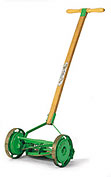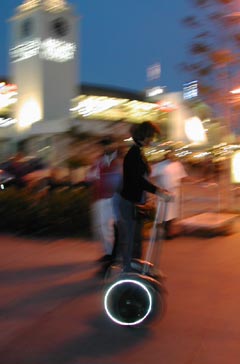|
...whee. Plus a little... |
||
|
Qik Clix: |
Q! Is it? A. With common sense and a little consideration. Gliding on a sidewalk is an exercise in three important things:
Unlike driving a car, the rules are more free-form. Unlike walking, the effort to do things is not based on taking the shortest, most efficient path. Unlike bicycling, it is a novel activity to nearly everyone you encounter, and they don't yet have a model in their heads as to how this new thing works and what to reasonably expect. |
Updated 4 30 03 |
|
Bumper Sticker: |
A. You MUST keep all eyes and ears peeled. What would you say if I told you that in many urban areas, automobile drivers were NOT stopping to accommodate pedestrians? Yep, the sad truth is that many, many motorists will leave a parking lot by rushing the nose of their car all the way to the edge of the street (or farther), rather than halting at the edge of the sidewalk, first where a pedestrian, wheelchair or HT may show up unannounced. Since you and your HT are moving faster than a walking person (who might avoid colliding with the nosy car simply because their speed is so slow), guess whose job it is to watch out for the cars? Yours. The sane way of traveling along sidewalks includes keeping an eternal vigil for these drivers. Later, as you get behind the wheel of your own car, you will notice how your HT experiences are adding to your own awarness of pedestrian and sidewalk traffic. People who are in electric scooters, electric wheelchairs and even kids on bicycles, encounter the same obstacle mix as you will on your HT. And all of them are equally vulnerable to this nearly universal driving habit. It occasionally runs them over, too. So don't let it happen to you. Slow before you come to blind driveways. Assume there will be an inconsiderate or habit-formed driver ready to exit without assurance that the sidewalk is clear. You WILL find more than 2% of those situations are occupied by a potential danger. In an hour's glide around the downtown area of my own small city (Glendale California is one of Los Angeles County's many city centers) I saw motorist unconsciousness more than three times. Assume the worst, and you will be safer. Slow before crossing alley outlets, driveway outlets and parking lot outlets that you can't see into before crossing. |
 |
|
A. Be afraid. Be very afraid. Just because you're paranoid, doesn't mean they're not out to get you. People have never seen a Segway. They can't tell by looking at it on a street corner that you will be across the street faster than a pedestrian walking. How could they? So they'll scoot around the corner to get the advance on pedestrian traffic, or if they see you coming, they'll stop, now blocking the up-ramp on the other side with their partly-cornered car. Often this will put you in a bind. You won't be able to get to the up-ramp, and now you are out in the cross walk, stranded. And so are they, in a way. Some will back up, but not all can when traffic closes in behind them. You may have to inform drivers of their mistake, but since they're in a brand new situation, diplomacy helps. One form is the finger point indicating your needed path, or more elaborate point and emphasis that where you are going is on the other side of their car. Harder to gauge are the motorists that stop to watch you go. You're the novelty here, so they may want you to complete your move just so they can see how the HT performs. You may have already issued a gesture waving them on or through, so another gesture acknowledging their audience status may be in order. In any ambiguous case, take things slow so you can stop or back up easily should you or the driver misunderstand. Remember, they're probably thrilled to see you, and they'll be doubly disappointed if you get gruff with them. The last thing we need are motorists retuning home with the story, "I saw one of those HT things on the street. The guy was a jerk. They ought to ban those things." As you glide across street pavement, keep this in mind. The people who maintain streets are not thinking about anything but their budget and car traffic. They build street corners that have ramps up to sidewalk height to live up to the letter of the Americans with Disabilities Act (ADA) and all too often make those ramps too steep for real people in real wheelchairs (according to those who are in real wheelchairs), so what makes you think they're interested in doing a Good Job? Sure, some are, but they're in the minority. And so are you. Big car wheels can go over small pot holes, so why bother with expensive minor fixes? But your Segway's wheels can find them and the bump, twist or bounce could throw you.
Case in point: Night gliding. In California, an EPAMD (Electric Personal Assisted Mobility Device) or HT is not required to have lights in exactly the way a bicycle at night is. Neither are sidewalk pedestrians. But the condition of sidewalks can be --let's face it-- relatively appalling. I don't doubt that these two words are rarely combined. Either something is bad or it crosses over to appalling, but relatively? That's a new one. Yet one can go for blocks and encounter cracks that don't wander from perfection by more than a few millimeters, then find a stretch that looks like it was engineered by a kindergartner. Roots, time, weather and earthquakes have conspired to tear up the pavement and dump you off your HT. The city's response has been to tar-paper over the worst edges and disregard the rest. People in wheelchairs and seated scooters know all about these stretches and have long since stopped bitching to city fathers about them. If they had been listened to, the paths would have been more effectively dealt with, but the department of sidewalks and pedestrian accommodation generally falls to the least capable bureaucrat. Now the wheelchair users have a new ally: You and your fresh eyes, as witnessed from the back of an HT. The reason is this: As you glide around an area, eventually you will encounter it under less than ideal lighting conditions. Dusk and night will present you with a problem. How can you glide safely over a surface you can't read accurately? Wheelchair and scooter -bound folk know this, far too well.
More than simply illuminating the way ahead, they want to know its topography. And that means a different form of lighting. The first SegwayLA meeting showed an attendee, J. Gassor, whose theory about lighting turned out to be extremely accurate. He had found a lighting system from NiteRider that velcro-wrapped into place a battery pack and separate headlight. The system allowed placement of the light low on the column, as pictured here, indoors. Now that night experiences have been acquired, the usefulness of this sort of very-low-position can be appreciated. Since the glider is standing, the rider's eyes are around six feet up or more. The light, beaming out from its low position, is aimed more horizontal than it would be from a handlebar mounting. It rakes at a shallower angle across the way ahead and highlights any surface features that intersect its beam. Those details will stand out, since they reflect more light than the flat pavement. Transitions that drop away on the other side of a portion of pavement will create deeper, wider shadows and call attention by being graphically bold. If the light is too low, and its beam is not diffused enough, drops won't be easy to estimate, but lifts will still highlight. The trick is to find the right amount of middle ground for the angle, intensity and diffusion of the light source. What may be better than the light seen here is an LED based system that can be positioned similarly. Many stretches of urban sidewalk are only illuminated by spill over from street lights. Sidewalk lighting is rarely implemented unless the city fathers are particularly alert, or high-volume foot traffic has been anticipated. We who glide will doubtless cause a slow renaissance in non-street transportation. Where urban planners had been giving auto traffic the enormous lion's share of consideration, the needs of the gliders, pedestrians, wheelchair and scooter traffic will cause areas of sidewalk to evolve to the glidewalk stage where everybody wins. Smooth, well-lit sidewalks mean fewer pedestrian trips and falls, too. |
||
|
Segway |
A. The Best Defense is a Good What? Defense. Ask the turtle. They outlive Cheetas by a factor of ten or more. You and your Segway HT are new stuff under the sun. Drivers and pedestrians don't yet have an intuitive understanding of how HTs work and what they can do. If a motorist sees you, they will be intrigued. Some will follow you for a few blocks. Others will stop inappropriately and try to engage you in conversation from the middle of the street. In the mean time, you are trying to spot the problem areas in the pavement ahead, register where the obstacles are, look out for potholes or dips, leave clearance for pedestrians and glide safely. "Hey, buddy! Where can I get me one of those?" shouted to a Segway glider half way across an intersection is not a good basis for conversation. As the target for questions, you are in a spot. You need to acknowledge them but can't always engage them. Wave and keep going. After all, your safety is your most important product. In the intersection, you are at your most vulnerable. You could be gliding in front of an SUV that blocks you completely, while to another driver in a hurry, coming up on the other side, you would be invisible until the crunch of Segway-Meets-Bumper happens. Crossing the street on the leg of the intersection that has you moving counter-clockwise to the center of the intersection is safest. Cars stopped at the other side have more time to spot you and make accommodations. Left-turners can see you because you are in their relatively forward field of view. Right-turners moving in your direction are looking out for pedestrians. Travel on intersection legs that take you clockwise. That puts you in front of traffic that is initially closer, but the rest of the intersection includes people turning right in the lane to your immediate left and those turning left from lanes moving towards you. Right-turners have the slight disadvantage of having you just outside the right side of their peripheral vision as they begin to move so they may start to make the turn before realizing you have claimed the crosswalk. One of the best habits you can create is getting to know where all the cars are around the intersection before you move into the street. Better yet: get eye-contact with any drivers that want to use the space you will travel on. |
This site is not affiliated The opinions expressed here are mine and mine alone. © 2003 Peter iNova, all rights reserved. Every last one of them.
non-Segway |
|
An unexpected benefit of gliding around your community is the authentic, personal and memorable contact you make with it. Sure, people are glad to see you on that new-fangled thingie, and their smiles, questions, willingness to interact, curiosity and greetings are a bonus, but let's move the clock a bit forward and see what gliding brings in the not-so distant future when the HTs are not such a novelty. For one thing, gliding lets you see the city or community in detail. The nature of the HT's driving habit is to be more alert than you are when simply walking. When you encounter an area for the first time, your sheer range of effortless investigation allows you to see and feel it in ways that walking does not. For instance, you would never walk a hundred yards this way and that just to see what things looked like from over there, unless you had a pretty good idea to begin with that the walk would be worth it. On the HT, serendipity can happen. There is no need to optimize your footsteps. Go ahead, roll on over and take a look, then roll back. No particular effort, but the reward is that your understanding of the place has been enhanced. Driving by my architecturally interesting City Hall and Administrative Offices never gave me a sense of participating in it. Gliding did. I could leisurely explore its architecture and get an appreciation for its layout as never before. Several times I found myself gliding over to an area because a minor detail in the building caught my eye. Things that would not have been worth 400 feet of strolling now became subjects of interest that were accessible. I found neighborhoods to be richer in detail, businesses to be easier to browse, and all the nooks and crannies of the town were open to me in greater depth than they had been. The nooks and details had always been there, but for the most part, I had driven past them without being able to peer in, make a detour, investigate and understand them. Rolling past shops and restaurants, I realized that I could see more of what was for sale or for dinner. Gee, I have to come by here sometime and eat. In short, my whole city became more... mine. |
Top | |
|
|
||
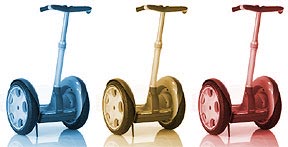 Safe
Yet
Safe
Yet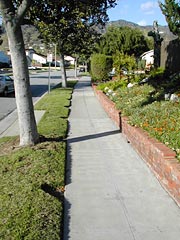 In an enlightened future, sidewalks and streets
will be maintained to a higher degree of perfection because HT's
will require it and an HT-using public will request it. This
will make wheelchair users rejoice, too.
In an enlightened future, sidewalks and streets
will be maintained to a higher degree of perfection because HT's
will require it and an HT-using public will request it. This
will make wheelchair users rejoice, too.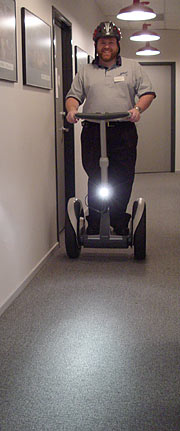 HT
gliders are interested in a slightly different form of understanding
about the surface ahead, one that would not occur to walkers
or bicyclists. They want to know where the lifts and drops, cracks
and crevices, holes and humps are.
HT
gliders are interested in a slightly different form of understanding
about the surface ahead, one that would not occur to walkers
or bicyclists. They want to know where the lifts and drops, cracks
and crevices, holes and humps are.
